My earlier post about Race Day as a whole didn’t say anything about what I was doing while the world was ending for some of the racers.
I can tell you what I wasn’t doing: Screaming my lungs out for the Vignottini, which would have been ridiculous considering that they were already five car-lengths in the lead. No danger of anything rear-ending them last Sunday if they’d come to a sudden stop. I felt cheated, somehow. I fully intended to be screaming. Never mind. Life will probably provide another opportunity for screamage.
What the Storica means for us at the club — and it’s more or less like this every year except this year it was even better than usual — is the following:
Saturday morning: Whoever is free comes to titivate their boat. There was a small chain gang working on the caorlina, and an even smaller one (including me) working on the gondolone. We had to sandpaper and polish all the brass, including the big ornamental ferri of the prow and the bow. Lino and Lucio worked at nailing and screwing down various bits that had gone adrift over the months, and then there was varnishing the whole thing. She is now a dazzling vision of delight, and will remain so for, oh, maybe a month. It depends on the weather how fast the brass will lose its luster.
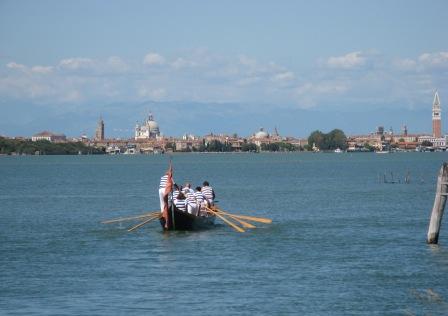
At 2:00 we dressed in our club best — blue and white tank top and white skirt (women), white pants for the men. Lino was dressed in his judge’s outfit, as he was on duty for two of the four races.
We rowed across the lagoon with some breeze but not too much. We crossed the Bacino of San Marco (waves, as always, but not as bad as usual because the traffic is limited this afternoon) and dropped Lino near San Marco, where he went to join the rest of his merry band of judges at the Tourism Office (regata division).
We rowed around the Bacino for a little while until it was time for the corteo, or boat procession, to form up. There is no real Italian way to express the concept of “forming up,” as the concept doesn’t exist. I’m not sure there is even anything close that you could compare it to, in order to explain to someone here what it might involve, or why it might matter. They’d just give you that “Well you’re perfectly welcome to try it if you want to but don’t get me involved” look.

Each boat has a number on its bow which indicates its order in the lineup. The number’s only discernible use is to help the speaker on the reviewing stand (the “Machina,” MAH-keen-ah) to identify the particular organization the boat belongs to as it drifts past. That part actually works pretty well.
We had number 11 and were probably two-thirds of the way back when the thing got going. You ask why we were so far back? Because the corteo wranglers had given absolutely no signal of any kind to indicate the imminent departure of said corteo. Evidently order isn’t foremost on their list of concerns either.
So we rowed in a slow and stately way up the Grand Canal (sometimes I surprise myself, at how normal doing something like that has come to be — then I suddenly snap to and think, Holy Crap! This is incredible!). The first regatas that might correspond somewhat to the current “regata storica” were arguably the series of races organized in January 1315 by doge Giovanni Soranzo. (In the 19th century it was called the “regata reale,” or royal regata). The corteo was added to the program much, much later, to evoke the arrival in Venice in 1489 of Caterina Cornaro, a Venetian noblewoman who was briefly also queen of Cyprus. It’s as good an excuse as any to add just that much more glamour — or glitter or marabou or whatever looks good — to the event.
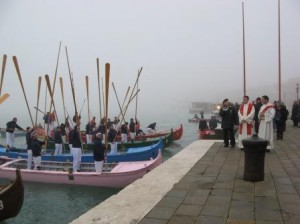
At certain points along the route we perform an alzaremi, or oar-raising, the classic Venetian waterborne ceremonial salute which looks thrilling. Too bad it’s been done to death by now. Lino thinks it should be limited to very few and very important moments, and I agree. But on this occasion, there are clumps of people all along the way who yell “alzaremi” at every boat just so they can snap a picture. It’s just one of the many, many ways in which a person here begins to be made to feel like a walk-on in somebody else’s entertainment.
But the sun is shining, there is music playing over lots of loudspeakers, people are leaning out of palace windows everywhere taking it all in, and it’s all just too splendid for words.
Then we turn around — I remember when we used to go as far as the train station, but every year people tend to break ranks and turn around sooner. There are some reasons for this, one of which, I think, has to do with resisting the idea of being compelled to perform for other people’s entertainment. That’s my theory. At least I resist that idea.
So we find a good place to park, as close to the finish line near the San Toma’ vaporetto stop as we can manage (on the shady, not the sunny side), and we tie up the boat. We pull out the vittles — cookies, tiny pizzas, peanuts, squares of homemade cake, fruit, etc. — and beverages, which are wine, water, and fruit juice. Very important, beverages. The heat can trick you and the one thing you don’t want to be in a boat is thirsty.
There’s another thing you don’t want to be in a boat, and we bring a small bucket for that. Nobody has ever had to use it.
This event used to have a dramatically different aspect. For decades, Lino would come early in the afternoon in his own little boat — as most people did — find a good place to tie up, and then eat and drink all afternoon, sharing with his neighbors, clambering over boats to go visit friends, and so on — much like the Redentore, but with races instead of fireworks.
In those days, the corteo consisted only of the bissone, or fancy ceremonial barges, and a long procession of black gondolas carrying every authority figure within reach — mayor, councilors, presidents of things, even the President of Italy on occasion. Then came the year when the Italian Prime Minister, Amintore Fanfani, had the misfortune of being rowed up the Grand Canal to the jeering shouts of a doggerel rhyme that works very well in Venetian (Fanfani! Fanfani! Ti ga i morti cani!). This is one of the absolutely worst insults in the Venetian universe and it basically means that your deceased relatives are dogs. I don’t think you have to speak Venetian to understand that it’s not your day.
This happened about 1976, as Lino recalls. Not long thereafter, the political party in power shifted to the Communist party and that sort of thing wasn’t tolerated at all. To make sure it didn’t happen by mistake, they just stopped sending their authority figures.
At the same time, after the first Vogalonga in 1975, there was a boom in new boat clubs, so the corteo began to be generally populated by boats like ours. civilians from rowing clubs who may also be tempted to shout rude things at each other, but it doesn’t make any difference when they do it. Since I’ve been here I’ve never seen a gondola with an official or notable aboard — just tourists, or paid costumed walk-ons.
Furthermore, for most of the “Storica”‘s history there was only one race: The gondolini. The races for women, boys, and men on the caorlinas were added gradually over the same mid-Seventies period. If you had to do triage and get rid of any races, I can tell you the only one they’d try to save would be the gondolini. Although the other ones are very nice.

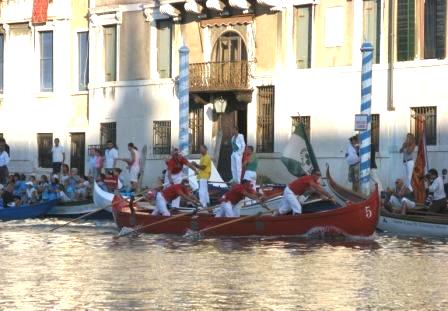
The most serious change in the past 20, or even 15, years is the steady decline in spectator boats. As I mentioned, Lino could climb over boats from hither to farther than yon all afternoon, but each year fewer Venetians come in boats to witness what was once one of their central events of the year. Even I have noticed the diminution of number of boats watching. There are many reasons for this but one of the primary ones is that the regata, on the whole, has been reshaped for tourists, either on land or watching TV, and therefore (for reasons I’ll spare you) it’s less interesting to be a participant. And the increase in motorboats has fatally weakened what was once a common language and connection with boats that are rowed.
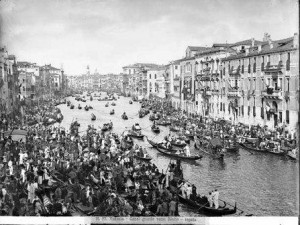
From being a crucial element of daily life for everyone, rowing has become a sort of boutique activity whose appeal is probably stronger as a picturesque curiosity to non-Venetians than to most locals, especially the younger ones.
Back to us. So we spend the afternoon hanging around watching the races and screaming if we should feel the need to for whoever our favorite racer(s) might be — and there have been times I have screamed so hard that I probably blew out some synapses, mine as well as the people nearest to me. I know the racers can’t hear me, but I also know they would notice if my voice weren’t in there somewhere. I know this. It’s a mystic racing thing.
As soon as the gondolini have crossed the finish line, everybody starts to leave. Instantly. Imagine everybody after the game trying to get out of the stadium parking lot at the same time. Lots of motors (not everybody who comes rows here anymore, unfortunately), and lots of motor-revving and choking exhaust fumes from these lovers of the oar.

Now comes almost the best part of all, which is the row back to the club. This takes about an hour because we’re not in a hurry; the sun is setting — it’s after 7:00 PM now — and the lagoon is calm and everyone is feeling happy and relaxed and it’s just one of the loveliest rowing interludes in the entire year.
We always stop, not far from the club, to open a bottle of wine (okay, two) and just sit and savor the moment out in the water all by ourselves. This year it was even sweeter than usual. The caorlina was not far behind us, and so we waited and then we tied the two boats together and just let the day and the moment and the sunset and the calm seep all the way through us.
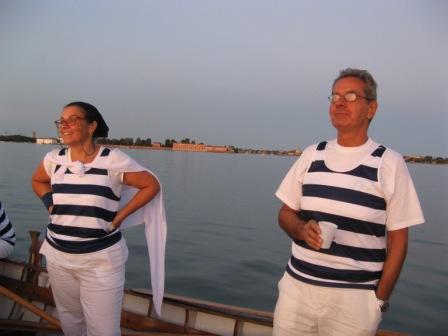

The moon, enormous and shining and orange, rose slowly above the treetops on the Lido. It was so beautiful it verged on the preposterous; Italians say that something like this, the final perfect touch, is the “cherry on the cake.” It was actually the moon on the cake. I’m sticking with that, at least I know what I mean.
The corteo is very nice, of course. But it’s something thousands of people (80,000 this year, by police estimates) can see, and anything that imitates something that once was genuine can hardly compare with something that is completely genuine right now. The corteo was a sort of imitation, but this was really ours. There were very, very few people who saw the lagoon as we did in the twilight with evening breath drifting around us and the moon’s radiance blooming out of the sky.
It all belonged to us and it needed no spectators or commentators. What a beautiful thing that is in this world, and how rare.

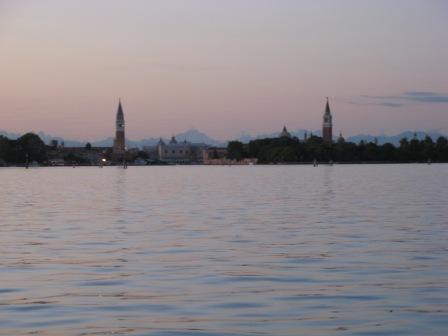
3 Comments
Thank you for both posts about the Regata Storica – this one and the other about the race. I enjoyed reading them, they made me feel closer to Venice again.
Well written article but I must admit that those wonderful photos definitely caught more my attention. Especially the last one. Beautiful view:)
Photos do tend to attract the eye more than words do. I’m glad you liked any or all of this post — I don’t quibble over the reasons!